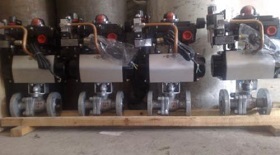Performance testing of pneumatic valves
1. When a certain specification of a valve is manufactured in batches, the authority should be entrusted with the following performance tests.
(1) Valve opening and closing moment under the condition of working pressure;
(2) Under the condition of working pressure, the number of continuous opening and closing can be ensured.
(3) The flow resistance coefficient of valves under the condition of water conveyance.
2. Valves should be tested before leaving the factory.
(1) When the valve is opened, the valve body should bear the internal pressure detection of two times the valve working pressure.
(2) When the valve is closed, the two sides are subjected to 1.1 times the valve working pressure value without leakage, but the metal seal butterfly valve and leakage value is not greater than the relevant requirements.
2. Internal and external anticorrosion of pneumatic valves
(1) Valve body (including transmission box) inside and outside, first of all should be shot blasting sand removal rust, and strive to electrostatic spraying powder non-toxic epoxy resin, thickness of more than 0.3 mm. When it is difficult to electrostatic spray non-toxic epoxy resin on oversize valves, similar non-toxic epoxy paint should also be brushed and sprayed.
(2) The inner part of the valve body and all parts of the valve plate require comprehensive anti-corrosion. On the one hand, immersed in water will not rust, between the two metals will not produce electrochemical corrosion. On the other hand, the smooth surface reduces the water resistance.
(3) Hygienic requirements for anticorrosive epoxy resin or paint in the body of the valve should be inspected by the relevant authority. Chemical and physical properties should also meet relevant requirements.



